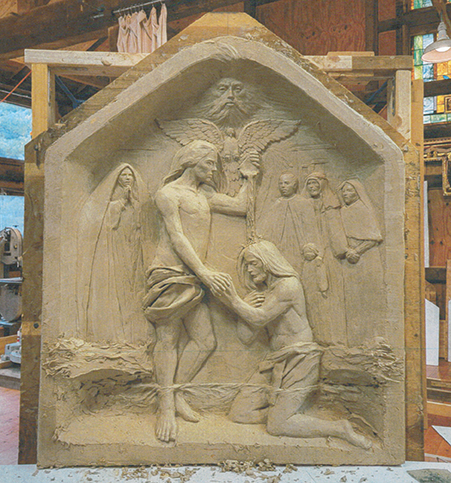Colleen Jurkiewicz
Catholic Herald Staff
Thanks to the generosity of an anonymous donor, visitors to the Archdiocesan Marian Shrine in Milwaukee will be assisted in contemplating the Luminous Mysteries of the Rosary by the addition of a dedicated monument to match the Glorious, Sorrowful and Joyful Mysteries.
Work has already begun on what will become the bronze panels depicting the Luminous Mysteries, which will be set in an edifice of limestone and located near the Glorious Mysteries.
The exact timeline of installation depends, however, on when the fundraising will be completed for construction of the monument and other related maintenance expenses at the shrine, said Archdiocese of Milwaukee Chief Financial Officer Chris Brown.
“I think it would be great if we could have this up by next spring, into the summer, before the Eucharistic Revival procession that comes through Milwaukee,” said Brown. “Since one of the Luminous Mysteries is the Institution of the Eucharist, it would be a great time to have this unveiled.”
This project was set in motion when Brown was approached by a parishioner at the Catholic Community of Waukesha who had recently received a bequest from the estate of a close friend, Mary Navin. He wanted the gift to be used for the addition of the Luminous Mysteries to the Archdiocesan Marian Shrine, said Brown.
“He came forward with this idea that he would pay for the production of the Luminous Mysteries,” said Brown. “Those are the mysteries that Pope John Paul II instituted (in 2002), so they weren’t there at the shrine as part of the original mysteries.”
Brown enlisted the expertise of Fr. Anthony Brankin, a priest of the Archdiocese of Chicago and a renowned artist. Fr. Brankin, a friend and classmate of Archbishop Jerome E. Listecki, who created the statue of Mary Mother of the Church that sits at the entrance to the archdiocesan Pastoral Center. When Fr. Brankin was in town for the dedication of the statue of Mary Mother of the Church, Brown took him to the shrine and asked if he would be willing to create the panels depicting the Luminous Mysteries.
While the initial donation covers the production of the bronze panels, Brown estimates it will cost several hundred thousand dollars more to complete the limestone monument and other needed repairs to the shrine. The Batzner Family Charitable Trust has come forward to cover the cost of tuckpointing the monuments containing the other mysteries.
Jeff Nicholson, volunteer coordinator for the shrine, described this addition as a continuation of the improvements to the Marian Shrine that began in 2018. Those improvements include benches, kneelers, LED lighting, power-washing and cleaning, statue repair, security cameras, birdhouse repair, pavers in front of the St. Joseph statue and the addition of an information kiosk with free items for the public, including Catholic books, Bibles and rosaries.
He called the addition of the Luminous Mysteries to the space a fitting one.
“Every single day there are people praying the Rosary at the shrine — people who come and visit on a regular basis as part of their routine,” he said. “Since Mary promoted the saying of the Rosary at Fatima, it’s fitting that we include the Luminous Mysteries.”
Pope John Paul II proposed the inclusion of the Luminous Mysteries in 2002 with his apostolic letter Rosarium Virginis Mariae, which also declared a Year of the Rosary.
“I believe … that to bring out fully the Christological depth of the Rosary, it would be suitable to make an addition to the traditional pattern which, while left to the freedom of individuals and communities, could broaden it to include the mysteries of Christ’s public ministry between his Baptism and his Passion,” wrote the pope. “In the course of those mysteries we contemplate important aspects of the person of Christ as the definitive revelation of God. … This addition of these new mysteries, without prejudice to any essential aspect of the prayer’s traditional format, is meant to give it fresh life and to enkindle renewed interest in the Rosary’s place within Christian spirituality as a true doorway to the depths of the Heart of Christ, ocean of joy and of light, of suffering and of glory.”
The Marian Shrine was built in 1947 in honor of Our Lady of Fatima, and has been owned by the Archdiocese of Milwaukee since the early 1980s, when it was handed over to its care by the Dominican Sisters of the Perpetual Rosary. Nicholson and about 20 fellow volunteers operate under the direction of Dcn. Steve Pemper, who was appointed by the archbishop to oversee the shrine.
“In my mind, this is completing the mysteries at the shrine — bringing it up to date to where we are with the mysteries today,” said Brown. “I’ve seen the work done and they’re absolutely beautiful depictions of the mysteries. I think it just turned out fantastic. They are beautiful pieces of work.”
Donations to support the shrine’s fundraising efforts can be mailed to the Archdiocese of Milwaukee, P.O. Box 070912, Milwaukee, WI 53207-0912, and clearly earmarked for the Luminous Mysteries Station Project at the Shrine (checks should be made out to Milwaukee Archdiocesan Marian Shrine). For other ways to support the project, Nicholson can be contacted at or 414-517-6915.

Five stations with the Luminous Mysteries of the Rosary are being added to the Milwaukee Archdiocesan Marian Shrine on 68th Street, just north of I-94. (Submitted photo)
